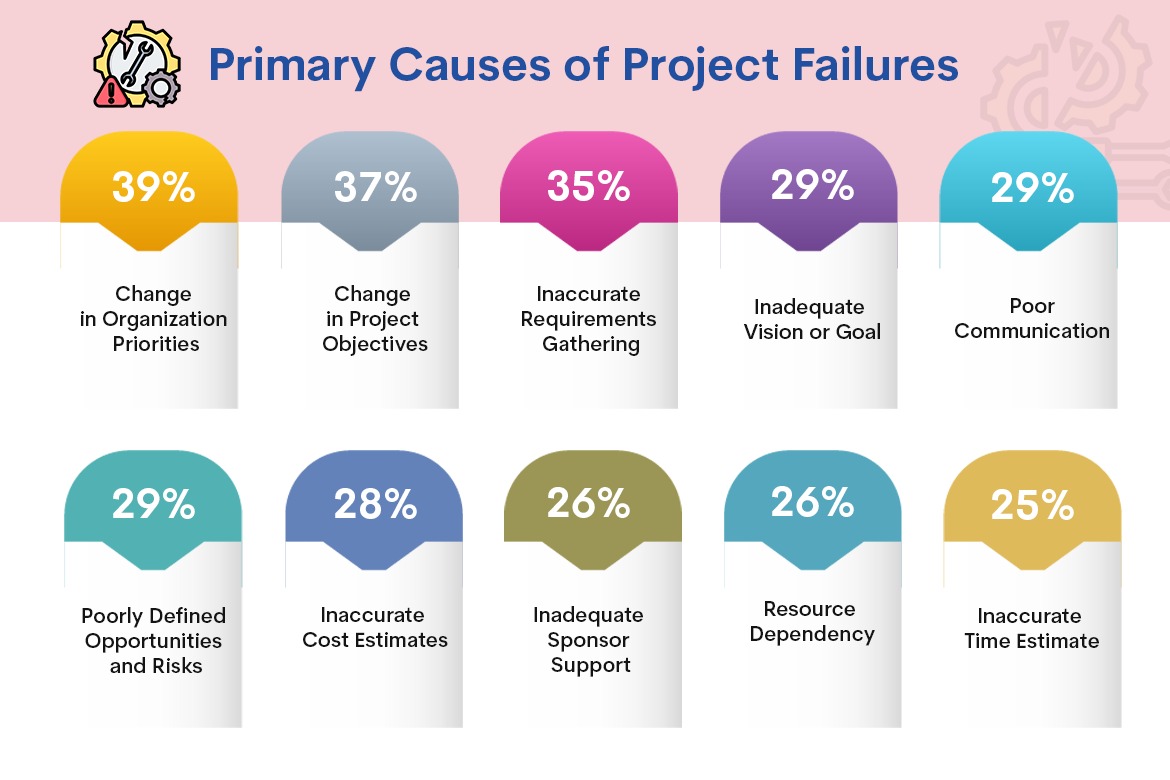
There are so many moving parts in an IT project that if any one part is not given adequate attention it can lead to the project failing as a whole. The project failure rate can be anywhere between 25% to 85% making it an accomplishment if your software development has been completed and delivered with hardly any hitches. However, successful projects often have certain common factors that drove success, and knowing the red flags that will cause challenges to your software project is important.
It is business’s nature that there will be risks but it should not happen during the development process. This would mean your business idea did not have the chance to be launched into the market and make a mark – or not. When failure is in-house then processes need to be relooked at. However, when a business trusts its project to IT outsourcing firms, it would be beneficial to know which vendor type has the highest probability of success.
The warning signs of project failure from your technical partner
Suppose ABC corporation hires an outsourced team to develop a new mobile app. The project is supposed to take seven months, with a budget of $200,000. After three months, ABC realizes that the project is running into trouble.
Here are some specific warning signs that the company observed:
The outsourced team has missed several project milestones and has not delivered key features on time. For example, according to the project milestone roadmap, the team was supposed to deliver a working prototype of the app within the first two months, but it has not yet been completed.
The company has reviewed the code produced by the outsourced team and has identified several issues, such as slow performance and crashes. The technical partner has not been responsive to the company’s requests for improvements.
The company also realized that the outsourced team has a different understanding of the project goals and scope of work. A well-developed scope of work should be a guiding mantra for both teams. In the absence of a detailed SOW, the outsourcing team had been working on features that were not requested by the company and have not been prioritizing key elements that were agreed upon.
Another red flag that the project has been over-promised without a good understanding of the deliverables is when the project starts exceeding the budget. The outsourced team has requested additional funds to cover unexpected expenses, such as hiring additional developers. This is in spite of the fact that the software team has not made significant progress nor has it been providing regular reports on the project status.
Based on these observations, the company realized it needed to cut its losses. Luckily they had the foresight to include clauses in the contract that covered such situations. They pulled out of the contract after 3 months and found a new vendor in iTech.

Also read: A guide to switching tech vendors with minimal risk to your business
The reasons for project failure can often be traced back to the start
In the case of ABC corporation, it was once bitten twice shy, in other words, it knew what to look for, the next time, in a new technology partner. It is true that most organizations do not crimp on the due diligence of potential IT outsourcing companies before deciding on a technology vendor. Yet IT projects can fail and it often boils down to these reasons:
- One of the biggest risks in choosing an IT outsourcing company is when the decision is guided by the low price. The low price could be an indication of less than stellar IT resources in the team. Every project requires a project manager, a database developer, Front/Backend or full stack developers, and designers. Most organizations outsource software projects cos it is hard to maintain such a team strength. Make sure your tech partner has them and look at each of their credentials.
- Up to 20% of the overall project budget can be spent on project management – it does not come cheap. Often to cut corners an IT outsourcing firm might forgo having a good project management team and it often results in more harm than good and that’s reflected in missed project milestones and poor communication with the client. Remember that Agile processes need a full-strength team.
- We have seen many cases of the wrong tech stack and architecture chosen leading to an ultimate project failure. For example, if the chosen tech stack cannot handle the project’s scale or complexity, it may result in poor performance, frequent crashes, and other technical issues that hamper the project’s progress. The only way to resolve it would be to refactor it from scratch. This is the point when organizations decide to look around for another technology vendor.
- The reasons for project failure are sometimes caused by the client. For example, if a client provides incomplete or vague project requirements, and is unavailable for discussions and feedback, it can be challenging for the development team to deliver a successful project.
How to rescue your floundering software project
It goes without saying that if your outsourced IT partner has already delivered you a project then it is easier for an organization to trust them with their next big project. However, if your IT partner is in a new working relationship with your organization and you are finding red flags popping up, here is how to try to get your project back on track:
Get a third-party expert review:
If you’re struggling to identify the root cause of the problem or come up with a plan of action, consider bringing in a third-party expert to review the project. An outside perspective can often help to identify issues that may have been overlooked, and they can provide recommendations based on their experience.
Conduct a risk assessment:
Take the time to assess the risks associated with the project and develop a risk management plan. This should include a list of potential risks, the likelihood of those risks occurring, and a plan for how to mitigate them. By being proactive about risk management, you can avoid delays and minimize the impact of unforeseen issues.
Re-evaluate your IT outsourcing company:
If you’ve identified communication gaps or other issues with your outsourcing partner, it may be time to re-evaluate your relationship. Consider whether the outsourcing partner has the necessary expertise and resources to deliver the project successfully. If not, it may be necessary to find a new partner or bring the work back in-house.
Refocus on project goals:
When a project is floundering, it’s easy to get bogged down in the details and lose sight of the project’s goals. Take a step back and refocus on the big picture. What is the project’s ultimate goal, and how can you get back on track to achieve it? By keeping the project’s goals in mind, you can prioritize tasks and make decisions that align with the project’s overall vision.
Project rescue services
Whether you have outsourced your software project to an external technical partner or you opted to do it in-house and now find you need help, identifying the obstacles and finding the right solution is essential for any project rescue program.
As a custom software development company that has rescued many such projects, we have found that the 3 Cs are crucial in successful project delivery.
Competence: The best talent pool drives innovation
Communication: Our iSupportPortal for each client, tracks every document and project status. Communicating good news is easy but our customers are informed well in time of any issues that might crop up – it is never represented as a client problem. Honesty builds a high degree of dependability.
Clarity: The 3rd C, Clarity in deliverables is always a deciding factor. Clients appreciate our engagement model that starts with a proof of concept that ensures we minimize your risk when selecting us as your technology partner.
Finally, have a look at our case study portfolio to understand the width of our experience and the global clients we have delivered, often, first-of-its-kind solutions.

Biju Narayanan
Biju is an emphatic people management leader and works by the vision that change is the door to new opportunities and innovation. As Director, he has been guiding iTech on a path of innovation for over 19 years. iTech is a full-service custom software company with a large portfolio of successful domestic and international projects including Fortune 500 organizations. Biju specializes in the healthcare, sports and logistics industries with particular focus on AI and ML. Outside of work, you may find him hitting a lethal jump smash on the badminton court and he is also a creative artist.





